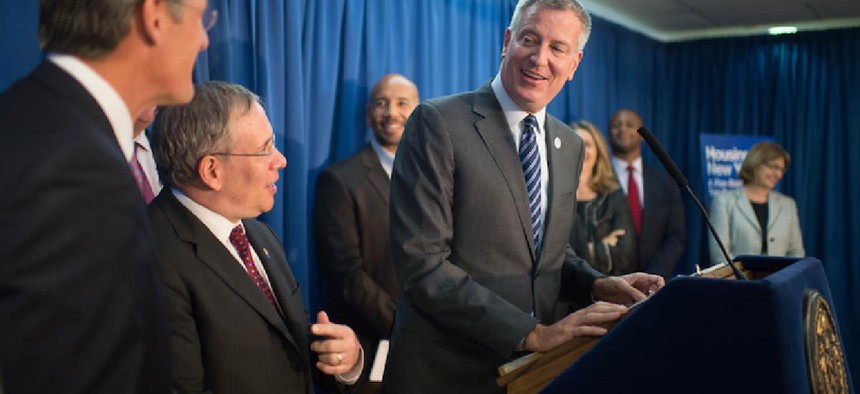With less than a year before the New York City mayoral primary, Comptroller Scott Stringer is flirting with the idea of challenging Bill de Blasio. If Stringer does want to try for it, he’ll have to come up with better ideas than he proposed at a major speech last month.
Part of Stringer’s predicament is any potential challenger’s predicament: life in New York is not bad. Stringer’s Sept. 22 speech to the Association for a Better New York didn’t mention crime – because crime remains at near record lows. This year, murders are down 3.7 percent and shootings are down 10.9 percent.
The economy, too, is doing well. As Stringer told ABNY, “our economy has seen seven straight years of growth,” with “nearly 550,000 private-sector jobs, and a higher percentage of our population … employed than ever before.”
Stringer did warn that growth has slowed, but nobody wins the mayoralty warning that we might have a recession – especially since, as the city’s chief financial steward, he offered no insight into how to cut spending.
And Stringer himself has contributed to one of the biggest problems a recession would pose. The comptroller signed off on the agreements de Blasio brokered with public-sector unions in his first year in office. Under those deals, the city is paying workers $2.7 billion, spread out until October 2020, for work that those workers already did before 2010, as the comptroller’s staff detailed in a 2014 report. Even if future tax revenues fall, the city must use future tax dollars to pay for past work.
Stringer’s best accomplishment so far is spearheading some genuinely interesting reports, on everything from how millennials are faring in New York compared to the previous generation (not great) and how crowded New York City’s housing is (crowded). These reports are a public service – but not exactly a launching pad for a mayoral campaign.
So instead, Stringer is echoing de Blasio’s bugaboo: inequality. “Make no mistake – a lot of people are better off because of this growth,” Stringer said. “But it’s just not true for all New Yorkers.”
Stringer’s marquee solution is subsidized housing. Slamming de Blasio’s plan to build or preserve 200,000 apartments over a decade as too slow, he proposed a “land bank” for 1,100 city-owned vacant lots. “My office estimates we could add up to 57,000 units of permanent low-income housing on this land,” he said, getting “New Yorkers off the waiting lists” for public housing, “off the streets, and out of our homeless shelters.” Stringer cited public housing as a model, noting that Depression-era NYCHA developments have grown “to house 400,000 New Yorkers in permanently affordable apartments.”
Yet Stringer is proposing what de Blasio is already doing, just more of it, and faster. In a response to a February audit by Stringer’s office, de Blasio’s staff said that of the properties Stringer catalogued, “approximately 670 are suitable and feasible for residential development,” with buildings going up on 400 starting in the next two years.
It’s hard to see how the city could move any faster. Because of neighborhood opposition, getting even a few hundred new subsidized apartments built takes months. And unlike de Blasio, Stringer emphasizes low-income housing, rather than moderate- and middle-income housing. Low-income tenants – such as NYCHA residents – cannot pay for the monthly upkeep on their apartments once the apartments are built. They need higher-income residents to carry those costs, and building 57,000 low-income apartments would require either tens of millions of dollars in permanent annual tax subsidy, or the construction of tens of thousands of even more expensive apartments to subsidize the lower-income units.
But such density would intensify community opposition. And if Stringer intends to use most of this housing for homeless New Yorkers, the city would have to spend even more on mental health services, addiction rehab services, security costs and other expenses that go with a troubled population.
The other big idea Stringer presented in his September speech was to triple the city’s earned income tax credit. This program supplements a federal tax program under which poorer working New Yorkers pay negative income taxes; that is, federal, state and local taxpayers who earn more redistribute their income to lower-earning New Yorkers. The program is successful in that it encourages people to work at low-wage jobs. Stringer’s increase would add $220 to the average recipient’s nearly $3,000 in extra annual income.
Expanding the earned-income tax credit is a fine idea – but it would cost $200 million annually. Stringer hasn’t proposed a way to pay for it. Yes, it’s easy to find an extra $200 million amid $54.6 billion in city tax revenues when the economy is booming. As with the housing idea, though, this strategy is to take de Blasio’s method of operation – give a little bit more of the ever-growing budget each year to each of the city’s key constituencies – and do more of it.
New Yorkers could benefit from a competitive primary race. But if Stringer wants to be his competitor, he’ll have to differentiate himself from de Blasio, not try to be a better version of the current mayor.
Nicole Gelinas is a contributing editor of the Manhattan Institute’s City Journal.


